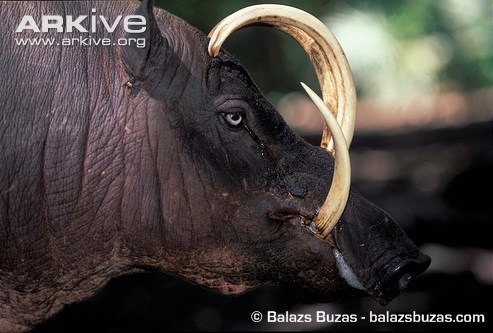| Citation |
|
Description |
Geographic Range [top]
Range Description: >B. babyrussa occurs on two of the Sula Islands (Mangole and Taliabu) and on Buru (Macdonald, 1993) in Indonesia. The species is reported to be extinct on Sulabesi (formerly Sanana) (Sol unpublished, 1986).
Countries occurrence:
Native:
Indonesia
Additional data:
Range Map: Click here to open the map viewer and explore range.
Population [top]
Population: The current population status of B. babyrussa is unknown. Although the forests in the northern portions of Buru have been degraded and cleared in the coastal lowlands, two large, contiguous, remaining forest blocks remain and current threats to the forest appear low (Wikramanayake et al., 2001). Most of Taliabu, the largest of the Sula Islands, is still forested, but there has been large-scale logging in the lowlands. Mangole, the other Sula island with babirusa, has been heavily degraded (Wikramanayake et al., 2001). Babirusa continue to be hunted for meat by local non-muslim village communities in some areas.
Current Population Trend: Decreasing
Additional data:
? Population severely fragmented: No
Habitat and Ecology [top]
Habitat and Ecology: Little is known about the habitat and ecology of the B. babyrussa specifically, but it is assumed that this is very similar than that of B. celebensis. Babirusa inhabit tropical rain forest on the banks of rivers and ponds abounding in water plants. In common with most of the other suids, babirusa are omnivorous and both wild and captive individuals consume a wide variety of leaf, root, fruit and animal matter (invertebrates and small vertebrates). At least on Sulawesi they visit volcanic salt licks and drink the water and ingest the soil (Clayton, 1996; Leus et al., 2002), so this might also be the case with B. babyrussa. Although detailed studies of their diet in the wild still need to be carried out, a review of the available information from the wild combined with studies on the stomachs and digestive abilities of captive animals suggest that from an anatomical/digestive point of view, they are most likely non-ruminant forestomach fermenting frugivores/concentrate selectors (Leus et al., 2004). Their jaws and teeth are reported to be strong enough to crack very hard nuts with ease. However, babirusa do not exhibit the rooting behaviour typical of other suids because of the absence of a rostral bone in the nose. They will probe soft sand as well as wet, muddy places for food.
Specific data are lacking for B. babyrussa, but in northern Sulawesi groups or troops of up to 13 individuals of B. celebensis have been observed in rainforest, especially around water, communal wallowing areas and salt licks (Patry et al., 1995; Clayton, 1996). Older adult males were often observed singly and most groups were composed of five or fewer animals, the majority of which were females with young animals.
Systems: Terrestrial; Freshwater
Threats [top]
Major Threat(s): Large-scale commercial logging operations have posed a major threat to this species (Smiet 1982). Current threats to the remaining Buru rainforests are low and the conservation outlook is relatively stable, but remains vulnerable - commercial logging and shifting cultivation are the primary threats (Wikramanayake et al., 2001). Babirusa continue to be hunted for meat in some places by local non-Muslim village communities.
Conservation Actions [top]
Conservation Actions: The babirusa was accorded full protection under Indonesian law in 1931 (Dammerman, 1950; Setyodirwiryo, 1959). The species has been included on Appendix I of CITES since 1982, although international trade in this species is not thought to be have been an important issue in recent times (Macdonald 1993).
There are two protected areas in the remaining Buru rainforest, Gunung Kelpat Muda (1380 km²) and Waeapo (50 km²), and one on Taliabu, Pulau Taliabu (700 km²) (Wikramanayake et al., 2001). Gunung Kelpat Muda, to the west-central part of the island. has the additional advantage of continuing to be an animal sanctuary according to local custom (Macdonald unpublished, 2008).
Citation: Macdonald, A.A., Burton, J. & Leus, K. 2008. Babyrousa babyrussa. The IUCN Red List of Threatened Species 2008: e.T2461A9441445. http://dx.doi.org/10.2305/IUCN.UK.2008.RLTS.T2461A9441445.en. Downloaded on 19 December 2018.
Disclaimer: To make use of this information, please check the .
Feedback: If you see any errors or have any questions or suggestions on what is shown on this page, please provide us with feedback so that we can correct or extend the information provided
|


